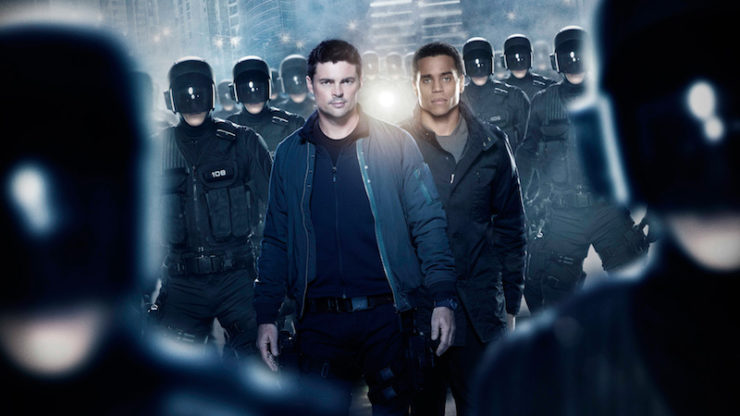Join us for a series of essays about science fiction TV series that, while popular with viewers, were cancelled early on by the networks. Some of the programs to be covered include Threshold (2005), Moonlight (2007-8), and the U.S. version of Life on Mars (2008-9).
“Let me explain something to you,” police detective John Kennex says to his commanding officer and another detective in the episode “You Are Here” (written by J. H. Wyman and Naren Shankar; directed by Sam Hill). “I’m a police officer. You’re a police officer. And, as much as it pains me to say it, Richard is a police officer. Now, you can dress these machines to look like cops; you can program them to drive a car and shoot a gun like a cop, but they’re not cops. They’re bullet catchers. And if you force me to work with a faulty machine, then I will dispose of it with the same degree of compassion that I would a toaster that burns my toast.”
In the Fox Network television series Almost Human, Detective Kennex’s rant about robot cops is not the norm. In fact, Kennex (played by Karl Urban) resists the technology that is an integral part of his world in the year 2048. In that world, every human police officer is paired with a combat-ready android known by the designation MX43. That is the norm that everyone else accepts. Kennex is forced to abide by that rule—but he doesn’t play well with the standard MX. Not at all.
The series was seen on the Fox network on Mondays at 8:00 P.M. from November 17, 2013 to March 3, 2014. Under the auspices of J.J. Abrams, it was created by J.H. Wyman. Wyman had pitched the idea for Almost Human to Abrams. In an online interview, Abrams explained: “Joel [Wyman] walked that tightrope of embracing the most human, relatable, emotional stories with the weirdest crap you’ve ever seen . . . What I loved about the show immediately was that Dorian, who was the synthetic cop, is far more human than his human partner. John [Kennex] is much more closed and emotionally compromised. A real piece missing. Kind of this damaged guy. Dorian is actually feeling, has a sense of humor, is kind and he has the kind of personality you want in a partner. He doesn’t have any of that monosyllabic or binary thinking that you would expect in a synthetic robot partner.”
At the heart of Almost Human is the relationship that a reluctant John Kennex forms with his second android partner (his first robot partner, a standard MX43, met with an untimely end when Kennex threw him out of his moving patrol car), an older model designated as DRN who prefers to be called Dorian (Michael Ealy). The formation of their mutual bond is an essential element of the story.
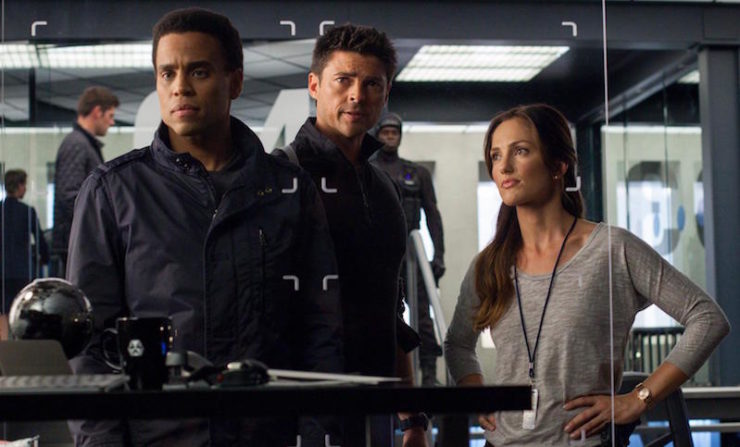
The pilot episode, scripted by Wyman and directed by Brad Anderson, rapidly sets up the reason for Kennex’s aversion to the MX43 model. Kennex leads a squad of his men and MXs into a fight against the primary adversary of the series, the Insyndicate. They are in a violent battle and Kennex’s human partner, Martin Pelham, is cornered and badly wounded. Kennex reaches him with an MX and orders the android to help get Pelham away from the gunfight. After diagnosing the seriousness of Pelham’s injuries, the MX refuses to help. He/it cites that others with a better chance of survival are in need of his help and leaves them. Kennex starts to lead his human partner away when a bomb explodes near them. Pelham is killed and Kennex loses his leg. Through a mist of gunfire and explosives, Kennex sees members of the gang approaching. He turns and crawls away but is caught in another explosion that sends him into unconsciousness.
Kennex is in a coma for seventeen months. Revived, he finds he has a lifelike synthetic leg that requires “calibration,” as a computer voice inside it often reminds him. He is haunted by a vague memory of seeing someone he knows at the Insyndicate battle but he’s unable to recall much of the event. To regain his memory, he goes to a Black Market district where a doctor, referred to as a Recollectivist, hooks him into an illegal device that helps restore lost memories.
Already reviling the MX43s because of the one that abandoned his human partner and himself, Kennex finds that he is required to be partnered with an MX in order to return to the force. In their patrol car, the MX threatens, in his matter-of-fact manner, to report Kennex for having been to a Black Market district, and that provokes Kennex to toss the android out of the moving car onto the highway. Exit one android partner. Enter a different kind of android partner: DRN0167.
When Rudy Lom (Mackenzie Crook), the precinct technician, introduces him to the decommissioned android, Kennex immediately recognizes the model: “That’s one of the crazies!” Rudy explains, “The DRN series—they were based on a program called synthetic soul. And while he isn’t ‘crazy’ as you say, there may be some bugs. . . . Some of them had difficulty dealing with their emotive regulations. Emotional issues. The idea behind the DRNs was to be as human as possible. The truth is, it’s human to have unexpected emotional responses. If its being as close to human was its goal, then, I guess, the DRNs weren’t such a failure after all.”
Kennex ignores the “small talk” that Dorian engages in as they ride in their patrol car. Dorian uses colloquialisms, referring to Kennex as “man.” Kennex tells him, “Don’t call me ‘man.’” For his part, Dorian complains that he doesn’t like being called a “synthetic.” When they report into the department, dour detective Richard Paul (Michael Irby) says to another cop, “Look at them. Two cops from the scrap heap.”
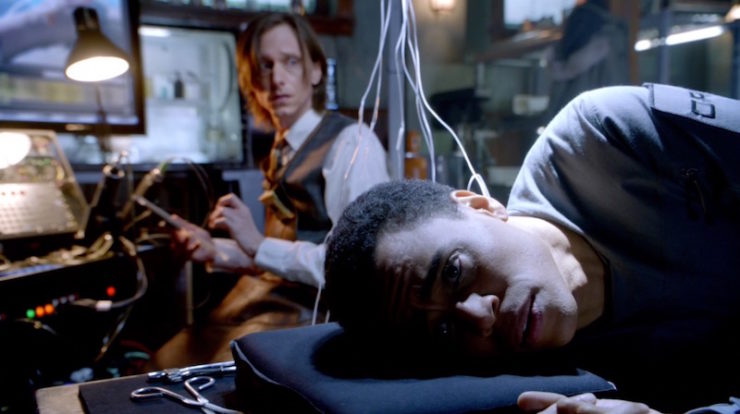
The two of them do have common ground. Dorian acts like a human. He expresses his feelings and a sense of humor. Still, he’s an android, an archaic one, at that. Kennex is thought of as a rogue. Detective Paul dislikes him because he had been the squad leader who led the attack against the Insyndicate. Paul feels he shouldn’t have survived that battle when so many in his squad had died. Feeling the weight of that guilt, Kennex says he’s not ready to return to police work. He’s a loner and, as J. J. Abrams said, he’s “this damaged guy.” It seems to me that the title of the series can relate to Kennex and Dorian equally.
In the course of the pilot episode, we see the gradual acceptance of Kennex for his new partner. The change begins, I believe, when Kennex is interrogating a gang member who had been caught during an armed robbery. Kennex and Dorian need to know where the gang is holding an abducted cop. While Dorian watches, Kennex uses strong-arm methods to get the suspect to talk. Suddenly, Kennex’s synthetic leg goes out on him and its computer sounds: “Synthetic failed. Calibration required.” Dorian takes the opportunity to address the suspect with an observation. “You shot yourself. Perhaps it was a bit crazy this morning. Maybe the doctors at county even missed it. But the trajectory of the bullet that hit you burned marks on your flesh. Basically there’s no chance that you were hit by any bullet but your own.” This gets a response from the suspect: “You don’t know the people I work for. I needed to get away from them any way I could. Because there’s no getting away from them.” With a nod, Kennex acknowledges Dorian’s tact in opening up the suspect.
When they go with a tactical team to the address that the suspect gives them, an MX halts them in a hallway. A trip wire attached to a device runs into the apartment and the MX notes that it could be a bomb. Dorian steps forward to examine the device more closely. He tells the tactical team, “It’s not a bomb. That trip wire leads somewhere.” He turns to Kennex. “I’ll lead you in?” The MX warns, “I do not advise that, sir.” Kennex looks at the MX, then at Dorian, then makes his choice: “Let’s go.” He follows Dorian. I see that move as a trust being formed between two partners.
What clinches for me the allegiance that Kennex feels toward Dorian occurs when Kennex returns to the Recollectivist to remember a key part of the Insyndicate battle that put him into a coma. He has seen images of his former girlfriend Anna and has an urgent need to learn why his thoughts of her seem connected to that epic fight. Coercing the Black Market doctor to put him under, Kennex does remember but at the cost of going into cardiac arrest. The doctor brings him out of his blackout state, but it’s Dorian who resuscitates him, saving his life. Dorian had traced Kennex through the GPS chip that every cop is required to have.
In their patrol car drive, where much of the camaraderie between them takes place in further episodes, Dorian asks, “I assume you want quiet mode, Detective.” Kennex, who is driving, replies, “Not necessarily. Call me John.”
We see a reciprocity developing in the relationship between Kennex and Dorian in the second episode, “Skin,” written by Cheo Hodari Coker and directed by Michael Offer. A criminal organization, the Albanian Consortium, is enhancing a stolen technology by abducting young women and, through a specialized scientific process, transferring their flesh onto robotic escorts. The case that Kennex and Dorian are on involves the kidnapping of a young woman, Kristin Haseman, in a parking garage. They have one eyewitness: Kristin’s young son Victor who was left in her car. When Victor asks when his mother is coming back, Dorian becomes worried over the prospect of having to tell him that his mother may not.
In their patrol car, Dorian seeks help from Kennex on that point:
Dorian: What do you tell a small child when someone dies? I’ve never considered that. What do you tell a small child?
Kennex: You say the same thing that you would say to an adult.
Dorian: What do they say?
Kennex: You tell him that the person who died has gone to a better place.
Dorian: Why would anyone say that when there’s no way to really know where living things go when they stop living?
Kennex: It’s designed to give hope, comfort, ease the pain. People believe it because they need to.
Dorian: The data I’ve studied suggests that the best proof of one’s existence is if one is remembered after they’re gone.
By asking these questions, Dorian reveals a kind of innocence about human life. He hadn’t questioned himself, nor anyone else, about what happens to an android when he’s shut down. Dorian, who had been decommissioned for four years, hadn’t experienced “death” in the same sense as a human would have. In what he says, it’s clear that he separates himself from “living things.”
What engages me in watching Almost Human is the depiction of how far the technology of 2048 can go toward creating a robot that behaves and responds like a human. There’s more to this series than just following the opposing viewpoints of Kennex as a human and Dorian as a robot. Producer/creator J.H. Wyman is interested in the society as a whole and, specifically, how people perpetrating crimes use a changing technology.
The episode “Skin” is fascinating to me for its exploration of what makes a manmade android real enough to pass for human to the extent of being a suitable sexual companion. Investigating a murder, Kennex and Dorian question the dead man’s former business partner, Lorenzo Shaw. Their business is the creation of androids in the form of attractive young women used for sex. Essentially, it’s a 2048 version of a prostitution ring.
When Shaw is being questioned, he takes note of Dorian, recognizing that he’s an android. “I haven’t seen one of you in a while,” he tells Dorian. “The latest sexbots have a little of your old tech in them. They’re capable of bonding empathetically with their clients, sense their moods and respond accordingly. It’s a significant achievement.” Think back over your own sexual conquests. Is there some truth to this statement about the empathy and responsiveness of a sexually compatible partner? Food for thought.

The actress playing Vanessa in “Skin,” Ella Thomas, is remarkably convincing as the sexbot that provides the vital key for finding the location of the skin lab and rescuing the young mother who had been kidnapped. Vanessa stares frankly at Kennex and Dorian with unblinking eyes, mannequin-like, and when questioned expresses an endearing innocence. When Kennex tells her that they picked her up before her “owners” planned to destroy her, she responds: “Why would anybody want to destroy me? There are much much better things to do with me.” She turns specifically to Kennex and, as Shaw had described, uses the empathic program designed in her. “We don’t have to do anything if you don’t want to. I’m a very very good listener. People look for connections in very different ways. That’s all people are looking for is someone who cares about them. That’s what I’m here for.”
After the interrogation, Captain Maldonado (Lili Taylor) asks Kennex if he’s finished his report of the case. She says, “We’ll need individual certificates when the bot’s destroyed.” Maldonado realizes her gaffe when she looks at Dorian. “I’m sorry. We can’t have bots with human DNA. She has to be deactivated.” When the captain walks away, Dorian tells Kennex: “I’d like to be there.”
Dorian is alone with Vanessa, except for a technician working on her. Their brief exchange carries over euphemisms about death that Dorian had picked up from Kennex.
Vanessa: Where am I going?
Dorian: To a better place.
Vanessa: Will you be there?
Dorian: I will remember you.
Here, Dorian applies what he had learned to another android who is as innocent of human ways as he had been. Coming full circle, we see Dorian’s continuing growth toward humanhood.
The TV series also points out the advantages of Dorian’s being a robot. In “Are You Receiving?” written by Justin Doble and directed by Larry Teng, Dorian and Kennex are the only cops in a building where terrorists are holding hostages. Yes, this is the Almost Human version of the Bruce Willis movie Die Hard. At one point, Kennex and Dorian need to use the elevator shaft to reach a higher floor. Dorian insists on going it alone, saying, “I was made for this.” Jumping onto the elevator cables, Dorian scrambles up with champion speed, something Kennex wouldn’t be able to accomplish. As Dorian crawls through an air vent, the scene mimics Willis making his way in an air vent almost exactly.
The terrorists are identified by Captain Maldonado and her team in a nearby command post as high-level operators of the Holy Reclamation Army. But, just as in Die Hard, they are frauds. They are actually robbers with a secondary team breaking into a precious metals factory. Holding hostages and making demands are diversionary tactics that depend on the police shutting down power to the area so that the thieves could steal the ore in the nearby building without setting off alarms.
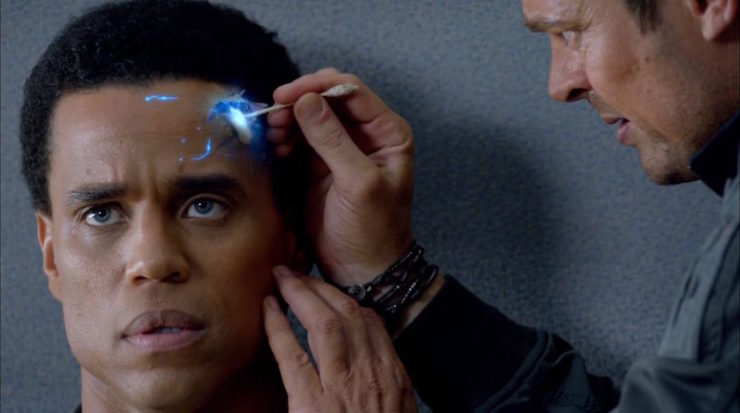
A technological twist has been added to what Hans Gruber had attempted in Die Hard. The terrorists are disguised through a futuristic means: the criminals wear realistic hologram-like facemakers. Who they really are goes undetected while closed circuit cameras and computer scans show only their fake identities.
Executive producer J.H. Wyman admits to using crimes and criminal activities as a means of telling these stories in Almost Human. “I could tell incredible stories about humanity in very different ways through lenses that we never have seen before on television,” Wyman told an online interviewer in 2013. “We’ve never experienced criminals like this. We can still tell great stories about murder, about jealousy, about love, anything that people have seen before in police procedurals but through a very different prism.”
Wyman is sometimes an uncredited co-writer on several of Almost Human’s episodes. He had worked with Sarah Goldfinger on the script for “Disrupt,” directed by Thomas Yatsko. It tells of a double murder committed through a near-possible technological means. A husband and wife are killed by their “smart home,” a computer-operated security system called Synturion. The house goes wrong when a highly-skilled hacker causes a pool cover to close over a pool where Linda Bennett is swimming. Michael, her husband, tries to save her but the house won’t let him, and when he tries to smash the pool cover, the house sees him as a threat and he’s shot to death as his wife drowns. It’s a clever mode of murder, but the plot is somewhat routine. It’s a revenge story with a few red herrings, including a cyberterrorist group named “Disrupt,” thrown into the mix.
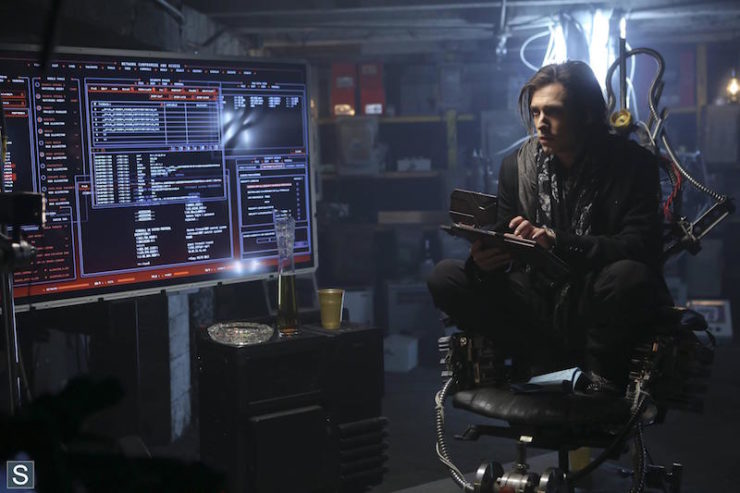
A major problem I see with “Disrupt” and a number of other episodes that are heavily into the police procedural plot is that a mystery is planted concerning major characters that remains unresolved. In this episode, Rudy Lom is analyzing Dorian as he is in sleep mode. Later, Dorian sees memories of a small child and he tells Kennex that he feels it’s himself. But, of course, Dorian had never been a child. At the conclusion of the episode, Rudy tells Kennex that someone had implanted those memories of childhood into Dorian. The question is who? And why? Mysteries that are not explored.
I find this a serious fallacy in Almost Human. Granted, each of the episodes are designed to be self-contained and without need for continuity. But why are some mysteries continued and resolved and some not? The episode “Unbound,” written by Graham Roland and directed by Jeffrey G. Hunt, reveals why the criminal gang in the pilot episode wanted to get to the evidence room in the police precinct. They wanted the literal head of a unique military android, a programed killer soldier known as XRN.
We are also introduced to the creator of the XRN, Dr. Nigel Vaughn, played by John Larroquette. Alone in his hidden lab, Dr. Vaughn greets the XRN, who he names Danica, but later, when Dorian and Kennex find him, he plays innocent. Dorian recognizes the doctor as the scientist who created him as well, and Rudy actually bows and kisses his hand, offering up idol-worship at meeting him.
The fallacy of an unresolved mystery crops up again in the last scene of “Unbound.” Although Danica is destroyed, Dr. Vaughn escapes. He is lifted up a cable thrown down to him by some unseen person or persons on the other side of “the wall,” an area mentioned in previous episodes. Dr. Vaughn has enough vials of the substance he created, synthetic souls, to build an army of XRNs. Here, then, is the problem: we are given no follow-up on Dr. Vaughn’s whereabouts. What is outside “the wall”? It seems to me there needs to be an episode in which Kennex and Dorian go outside to that mysterious area. Promises hinted at but never kept.
Almost Human was cancelled by the Fox network on April 29, 2014. A number of factors had been cited by online journalists at the time: low ratings, a viewer-deficient Monday night time slot, and Fox’s desire to place new pilots like Gotham and Empire into the lineup. According to TV.com’s Tim Surette, “The focus of the show often strayed from the most interesting parts of the series—the relationship between Kennex and Dorian and the idea of artificial intelligence—in favor of more procedural-y stories.”
I liked the show for layering their complex plots with extensions of today’s social issues like drug use among socially elite teenagers in “Perception,” harvesting and transplanting human organs in “Arrhythmia,” and Internet voyeurism in “Simon Says.”
Let’s stick to the positive here. What are your favorite episodes or scenes? Which technological enhancements extended from today’s science do you find convincing? How successful is the series in pointing out what is human in us? I’d be interested in hearing your views.
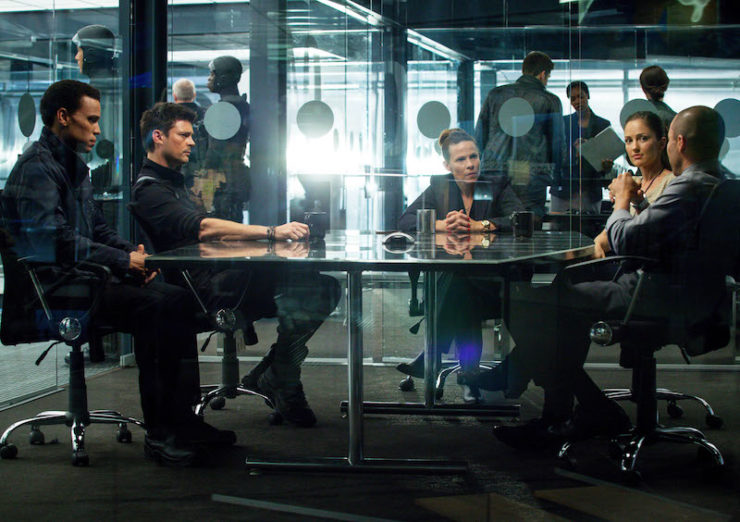
Note: This one is dedicated to the memory of
Stephen P. Stern,
Stalwart Friend and Colleague
He embraced life
Ted Krulik was born at the beginning of the television age. As a child, he watched first-run episodes of Rocky Jones, Space Ranger, starring Richard Crane, and the 1950s Flash Gordon, starring Steve Holland. A new and exciting series of the late 1960s, a little known TV show named Star Trek, filled Krulik with dreams of a someday world of aliens and remarkable technical devices. In the 1970s, Krulik attended the earliest Star Trek conventions in Manhattan. At one of these, he met George Takei, Ensign Sulu himself, who told him that Star Trek was never coming back to television except, maybe, as a new animated series. “You see,” Takei said, “all the sets have been struck; all the uniforms are gone. There’s nothing left to go back to.” Famous last words.










